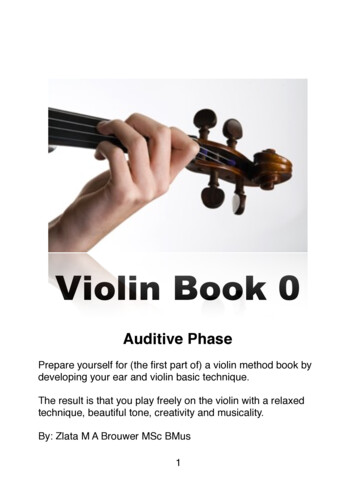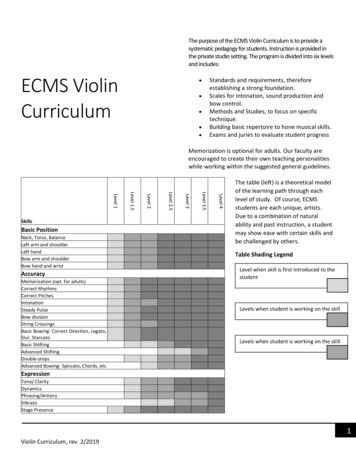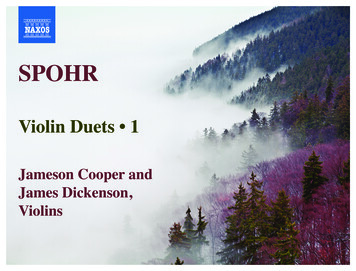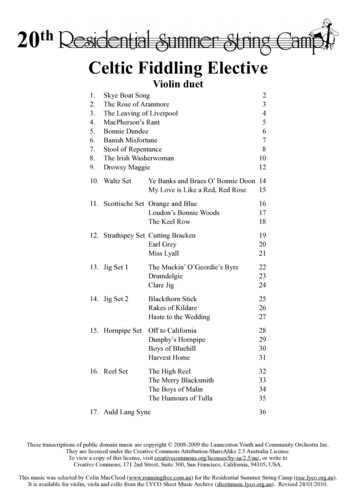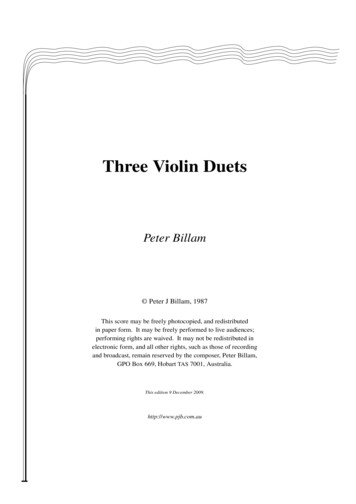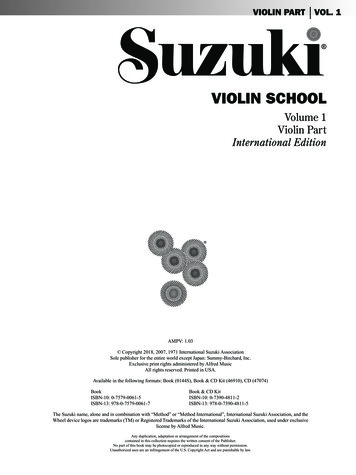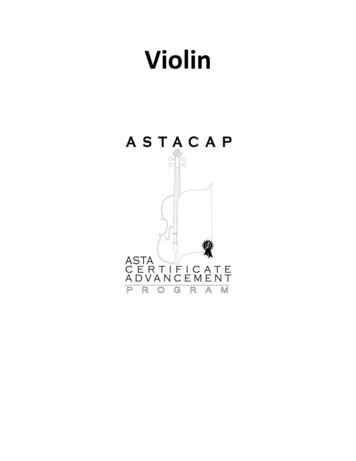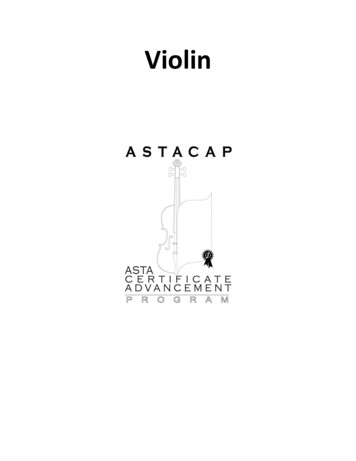
Transcription
Violin
Violin: Level 6Performance Exam RequirementsDuration of examination: 20 minutes Scales and arpeggios (Memory Highly Recommended)Play one from each category: Two-octave major scale in Eb, E, F, or F#. Slur four eighths or eight sixteenths.Three-octave major scale in Ab, A, Bb, B, or C. Slur one set of triplet eighths or four eighths.Three-octave melodic minor scale in G, A, B, or C. Slur one set of triplet eighths or four eighths.Two-octave harmonic minor scale in B or D. Slur one set of triplet eighths or four eighths.Two-octave G chromatic scale. Slur four eighths.Metronome: quarter 60–72Tonic arpeggios are required for all major and minor scales.Bowing for arpeggios: Slur one set of triplet eighths or four eighths. Etude (Memorization not required)One. Pieces (Memory Highly Recommended) One or two A sonata or concerto movement counts as one piece. Sight ReadingSight-reading is currently only part of the In Person exam.Range might exceed two octavesKeys up to three sharps and three flatsMeters: 4/4, 3/4, 2/4, 6/8, 3/8Note values might include dotted eighths and a sixteenth note and eighths restsSlurs of two, three, or four notes Ties First and third positionsRecommended Goals for Level 6Growing skills in shifting and playing in upper positionsPlaying chords and short passages of double stops with clear tone Increased skills with mixed bowingsDeveloping staccato and sautilléAccuracy in complex rhythmsMore fluid and even vibrato used in pieces.Beauty of tone in sustained passagesInitial sense for style in varied periods of music
Violin Repertoire: Level 6Aligned and Additional Repertoire for Study and ExamsPieces designated “NS” do not currently appear in the ASTA String SyllabusScale BooksStringTitle (Publisher)Syllabus1-2Anderson: Essentials for Strings (Kjos), 3-octave scales & arpeggios4Barber: Scales for Advanced Violinists (Preludio)3Brown: Two Octave Scales and Bowings for the Violin (Ludwig)4Flesch: Scale System (Fischer)3Hrimaly: Scale Studies (Schirmer)Etudes and Technical StudiesStringTitle (Publisher)SyllabusNSDancla: School of Mechanism, op. 74 (Schirmer)NSDancla: Twenty Brilliant and Characteristic Etudes, op. 73, Nos. (Schirmer)4Doflein: The Doflein Method, Vols. 4 & 5 (Schott)3Kayser: 36 Elementary and Progressive Studies, op. 20, Nos. 13-36(Schirmer)4Kreutzer: 42 Studies Nos. 2-10, 15, 17 (lnternational)3Suzuki: Quint Etudes (Summy Birchard)4Trott: Melodious Double Stops, Bk. 2 (Schirmer)3Whistler: Developing Double Stops (Rubank)3Whistler: lntroducing the Positions, Bk. 2, pp. 26-56, minimum eight lines(Rubank)
Violin Repertoire: Level 6 (continued)Pieces (continued on the next page)StringTitle (Publisher)Syllabus4Accolay: Concerto No.1 in Am (International); also in Barber: Solos for YoungViolinists, Vol. 3; minimum 3 pages3Bartok/Fulep: An Evening in the Village (Ed. Mus. Budapest)NSBlake, John & Harmon, Jody: Jazz Improvisation Made Easy (Harmon)3Bohm: Introduction & Polonaise (Fischer); also in Barber: Solos for Young Violinists,Vol. 2NSBohm: Perpetuum Mobile in C, op. 187, No. 4 (Fischer)NSCohen: Technique Flies High! (Faber)5Corelli: Sonatas, op. 5, Nos. 1-6 (Schott)4Corelli/Suzuki: La Folia, from Suzuki Violin School, Vol. 6 (Summy-Birchard)3Dvořák:: Sonatina in G, op. 100 (Henle); also in Barber: Solos for Young Violinists,Vol. 24Elgar: Salut D'Amour (Peters); also in Album of Violin Pieces (Amsco)4Fiocco: Allegro (International); also in Suzuki Violin School, Vol. 64Handel: Sonata #4 or #6 (Peters w/cello ad lib). Two movements together count asone.4Haydn: Concerto No. 2 in G (Henle)NSKreisler: Chanson Louis XIII et Pavane (Foley); in Fritz Kreisler Collection, Vol. 1NSKreisler: La Precieuse (Foley); in Fritz Kreisler Collection, Vol. 44Kreisler: Tempo di Minuetto (Fischer); in Fritz Kreisler Collection, Vol. 2; also inBarber: Solos for Young Violinists, Vol. 34Kreisler: Rondino on a Theme by Beethoven (Foley); in Fritz Kreisler Collection, Vol. 13Mlynarski: Mazurka in G (Fischer); in 37 Violin Pieces You Like to Play4Nardini: Concerto in Em (Schirmer)3Paradis: Sicilienne (Schott)
Violin Repertoire: Level 6 (continued)Pieces (continued)4Potstock: Souvenir Sarasate (Fischer)NSSaint-Saëns: The Swan (Carl Fischer)NSSitt: Concertino in D Minor, op. 65 (Eulenburg)NSSitt: Concertino in D Minor, op. 110 (Eulenburg)3Seitz Pupil's Concerto #3 in Gm, op. 12 (Schirmer)3Seitz: Pupil's Concerto No. 1 (Schirmer)4Severn: Polish Dance (Fischer)3Vivaldi: Concerto in Gm, op. 12, No. 1 (International); also inSuzuki Violin School, Vol. 5Alt. 5Lipsius, Fred, Reading Jazz Rhythms, violinAlt. 4O'Connor, Mark (arr.), LimerockAlt. 5O'Connor, Mark (arr.), Midnight on the Water, Five Pieces for Unaccompanied ViolinAlt. 5Ponty, Jean-Luc, Jean-Luc Ponty CollectionAlt. 6Venuti, Joe, arr. Massey & Romano, Joe Venuti: Never Before, Never AgainAlt. 5Wilkens, Jack, Essential Jazz Etudes: the Blue, violinNote: Teachers may choose any other works of comparable literatureSuggested Teaching Materials not appropriate for use in the examHebert: Donna Fiddling Demystified: A Practical Guide for String Players (violin) (Hebert)Schradieck: The School of Violin Technics (Schirmer)Ševčík: School of Bowing, op. 2 (Schirmer)Ševčík: Shifting the Position, op. 8 (Schirmer)Ševčík: Preparatory Exercises in Double Stopping, op. 9 (Schirmer)Ševčík: Preparatory Trill Studies, op. 7 (Schirmer)Ševčík: School of Violin Technics, op. 1, part 3 (Schirmer)
Violin: Level 7Performance Exam RequirementsDuration of examination: 20 minutes Scales and Arpeggios (Memory Highly Recommended)Play one from each category: Three-octave major scale in Ab, Bb, B, C, or D. Slur two sets of triplet eighths or eight sixteenths.Three-octave melodic or harmonic minor scale in G, A, B, or C. Bowings - same as above.Three-octave G chromatic scale. Slur two or four eighths.One-octave diminished arpeggio starting on G, A, B, or C. Slur two eighths.One-octave scale in G or A in double stopped octaves. Slur two eighths.Metronome: quarter note 66–76Tonic and subdominant arpeggios required for all major and minor scales.Bowing for arpeggios: Slur one set of triplet eighths. Etude (Memory not required)One Pieces (Memory Highly Recommended) One substantial piece, such as Monti: Czardas or Ten Have: Allegro Brilliant, or fast concertomovement One short contrasting piece from a different period. Sight ReadingSight reading is currently only part of the In Person exam.Range might exceed two octavesKeys up to three sharps and three flatsMeters 4/4, 3/4, 2/4, 6/8, 3/8, 9/8, cut timeNote values may include dotted eighths with sixteenths and eighth restsSlurs of two, three, four, and six notesSome shifting to second or third positionRecommended Goals for Level 7Accuracy of pitch and rhythmExtended fast passages played evenly and cleanlyDeveloping agility in trillsWorking on two-octave double-stopped scalesIncreasing bowing skills in sautillé, spiccato and complex string crossingMore power and beauty of toneGrowing familiarity with varied styles demanded by different periods
Violin Repertoire: Level 7Aligned and Additional Repertoire for Study and ExamsPieces designated “NS” do not currently appear in the ASTA String SyllabusScale BooksStringTitle (Publisher)Syllabus4Barber: Scales for Advanced Violinists (Preludio)4Flesch: Scale System (Fischer)3Hrimaly: Scale Studies (Schirmer)Etudes and Technical StudiesStringTitle (Publisher)SyllabusNSDancla: Twenty Brilliant and Characteristic Etudes, op. 73, Nos. 1-4 (Schirmer)5Dont: 24 Studies, op. 37 (Schirmer)3Kayser: 36 Elementary and Progressive Studies, op. 20, Nos. 13-36 (Schirmer)4Kreutzer: 42 Studies, Nos. 11, 13-14, 21-22, 24-25, 30 (lnternational)4Mazas: Etudes Speciales, op. 36, Bks. 1 & 2 (lnternational)3Suzuki: Quint Etudes (Summy Birchard)3Whistler: Developing Double Stops (Rubank)Pieces (continued on next page)StringTitle (Publisher)Syllabus4Ambrosio: Canzonetta, from 37 Violin Pieces You Like to Play (Fischer)4Bach: Arioso (Schirmer), advanced fingering; also in Perlman: Violinist's RecitalAlbum (Fischer)4Bach: Concerto in Am (Schirmer); also in Suzuki Violin School, Vol. 74Bach/Wilhelmj: Air on the G String (Fischer); also in Album of Violin Pieces(Amsco)
Violin Repertoire: Level 7 (continued)Pieces (continued)NSBridge: Perpetual Motion (Stainer & Bell)NSDesplanes: Intrada (Natchez)4Eccles: Sonata in G Minor (lnternational); also in Suzuki Violin School, Vol. 8NSFauré: Berceuse (Pressler)4Gluck/Kreisler: Melodie (Fischer)4Gretry: Tambourin, in Suzuki Violin School Vol. 84Handel: Sonata #1, 2, or 5 (Peters). Two movements count as one.NSIbert: Little White Donkey (Hanelle)4Keler-Bela: Son of the Puszta, Op. 134, No. 2; in 37 Pieces You Like to Play(Fischer)4Kreisler: Liebesleid (Foley)4Kreisler: Menuet in the Style of Porpora (Foley)5Kreisler: Schön Rosmarin (Foley)4Kreisler: Syncopation, from Fritz Kreisler Collection, Vol. 2 (Fischer)4Martinů: Five Madrigal Stanzas (Associated)4Massenet: Meditation from Thais (Boston, Fischer); also in Barber: Solos forYoung Violinists, Vol. 54Monti: Czardas (Fischer); also in Barber: Solos for Young Violinists, Vol. 54Mozart: Concerto in D, K. 211 (International)NSRieding: Concerto in E Minor, op. 7 (Bosworth)NSSchubert: Sonatina in D (Henle)4Schubert: The Bee, from 37 Pieces You Like to Play (Schirmer)NSTartini: Sonata in Gm, op. 1, no. 10 Didone Abbandonata (Ricordi)4Ten Have: Allegro Brillant (Bosworth)
Violin Repertoire: Level 7 (continued)Pieces (continued)NSVilla-Lobos: Canto de Cisne Negro, from 5 Pieces for Violin and Piano(Masters Music)4Viotti: Concerto No. 23 in G (Schirmer); also in Barber: Solos for YoungViolinists, Vol. 5NSVivaldi: Spring, from Four Seasons (Ricordi). 2nd and 3rd movements count asone movementNSWieniawski: Kuyawiak (Fischer)Alt. 6O'Connor, Mark, The Fiddle ConcertoNote: Teachers may choose any other works of comparable literatureSuggested Teaching Materials not appropriate for use in the examDancla: School of Mechanism, op. 74 (Schirmer)Ševčík: School of Bowing, op. 2 (Schirmer)Ševčík: Shifting the Position, op. 8 (Schirmer)Ševčík: Preparatory Exercises in Double Stopping, op. 9 (Schirmer)Ševčík: Preparatory Trill Studies, op. 7 (Schirmer)Ševčík: School of Violin Technics, op. 1, parts 3 & 4 (Schirmer)
Violin: Level 8Performance Exam RequirementsDuration of examination: 25 minutes Scales and Arpeggios (Memory Highly Recommended)Play one from each category: Three-octave major scale in Db, Eb, E, F, F#, or Gb. Slur two sets of triplet eighths or eightsixteenths.Three-octave melodic or harmonic minor scale in Bb, C#, or F#. Same bowings as the majorTwo-octave diminished arpeggio in G, A or B. Slur two eighths.One-octave scale in Eb, F, or G in double stopped sixths. Slur two eights.Metronome: quarter note 66–76Tonic and subdominant arpeggios are required for all major and minor scales.Bowing for arpeggios: Slur one set of triplet eighths. Etude (Memory not required)One Pieces (Memory Highly Recommended) One fast concerto movement Two short contrasting piecesThree pieces should represent three different composers. Sight ReadingSight-reading is currently only part of the In Person exam.Range might exceed two octaves Keys up to three sharps and three flatsMeters of 4/4, 3/4, 2/4, 6/8, 3/8, 9/8, cut timeNote values might include dotted eighths with sixteenth notes as well as eighth and sixteenth note restsSome ties might be usedSlurs of two, three, four, or six notesShifting to second or third positionRecommended Goals for Level 8Confidence and accuracy in shifting including double stopsDeveloping varied speeds and widths of vibratoMore speed and agility in bowing.Wider dynamic rangeMore power, projection and beauty of toneIncreasing conviction and musical maturity in a range of styles
Violin Repertoire: Level 8Aligned and Additional Repertoire for Study and ExamsPieces designated “NS” do not currently appear in the ASTA String SyllabusScale BooksStringTitle (Publisher)Syllabus4Barber: Scales for Advanced Violinists (Preludio)5Galamian/Neumann: Contemporary Violin Technic (Galaxy)4Flesch: Scale System (Fischer)3Hrimaly: Scale Studies (Schirmer)Etudes and Technical StudiesStringTitle (Publisher)SyllabusNSDancla: Twenty Brilliant and Characteristic Etudes, op. 73, Nos. 5-6,8-9, 13, 16-17 (Schirmer)5Dont: 24 Studies, Op. 37 (Schirmer)5Fiorillo: 36 Etudes or Caprices (International)4Kreutzer: 42 Studies, Nos. 1, 12, 19, 26-27, 34, 42 (lnternational)4Mazas: Etudes Brillantes, op. 36, Bk. 2 (International)3Suzuki: Quint Etudes (Summy Birchard)3Whistler: Developing Double Stops (Rubank)Pieces (continued on next page)StringTitle (Publisher)Syllabus5Bach: Concerto No. 2 in E (International)5Bach: Solo Sonatas and Partitas (Internationa)lPartita No. 2 in D Minor – AllemandePartita No. 3 in E Major – Bourree, Minuet 1 and 2, Giga5Beethoven: Romance in F (Fischer)4DeBeriot: Concerto in G, op. 76, no. 7 (Fischer)
Violin Repertoire: Level 8 (continued)Pieces (continued)4DeBeriot: Concerto in Am, op. 104, no. 9 (Schirmer)5De Falla: Suite Populaire Espagnole, Jota or two other movements (Chester)4Drigo: Valse Bluette; from 37 Pieces You Like to Play (Schirmer)4Dvořák: 4 Romantic Pieces, op. 75 (Simrock) Play at least two.NSFoss: Composer's Holiday (Fischer)4Gardner: From the Canebrake, op. 5, no. 1 (Schirmer)4Grieg: Sonata in F, op. 8, no.1 (Peters)5Haydn: Concerto No. 1 in C (Henle)4Hubay: Hejre Kati, op. 32, no. 4 (Fischer)4Kreisler: Sicilienne and Rigaudon (Foley) (NSKreutzer: Concerto No. 13 in D (Fischer)NSMozart: Concerto No. 1 in Bb, K. 207 (Bärenreiter)4Mozart: Concerto No. 3 in G (Schirmer)NSMozart: Rondo in C, K. 373 (International)5Mozart: Sonatas, K. 301 in G / K. 304 in Em / K. 305 in A (Henle)NSO'Connor: The Fiddle Concerto (Mark O'Connor)NSRavel: Piece en Forme de Habanera (Leduc)NSSarasate: Playera, op. 23, no. 1 (International)NSSchubert: Sonatinas in Am and Gm, op. 137 (Fischer)NSSpohr: Concerto No. 2
Violin: Level 6 Performance Exam Requirements Duration of examination: 20 minutes Scales and arpeggios (Memory Highly Recommended) Play one from each category: Two-octave major scale in Eb, E, F, or F#. Slur four eighths or eight sixteenths. Three-octave major scale in Ab, A, Bb, B, or C. Slur one set of triplet eighths or four eighths. Three-octave melodic minor scale in G, A, B, or C. Slur .
